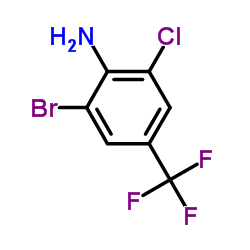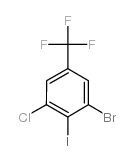2-Bromo-6-chloro-4-(trifluoromethyl)aniline
Modify Date: 2025-08-23 05:58:28

2-Bromo-6-chloro-4-(trifluoromethyl)aniline structure
|
Common Name | 2-Bromo-6-chloro-4-(trifluoromethyl)aniline | ||
|---|---|---|---|---|
| CAS Number | 109919-26-8 | Molecular Weight | 274.466 | |
| Density | 1.8±0.1 g/cm3 | Boiling Point | 224.8±40.0 °C at 760 mmHg | |
| Molecular Formula | C7H4BrClF3N | Melting Point | 27-30 °C(lit.) | |
| MSDS | USA | Flash Point | 89.7±27.3 °C | |
| Symbol |

GHS07 |
Signal Word | Warning | |
| Name | 2-bromo-6-chloro-4-(trifluoromethyl)aniline |
|---|---|
| Synonym | More Synonyms |
| Density | 1.8±0.1 g/cm3 |
|---|---|
| Boiling Point | 224.8±40.0 °C at 760 mmHg |
| Melting Point | 27-30 °C(lit.) |
| Molecular Formula | C7H4BrClF3N |
| Molecular Weight | 274.466 |
| Flash Point | 89.7±27.3 °C |
| Exact Mass | 272.916779 |
| PSA | 26.02000 |
| LogP | 4.02 |
| Vapour Pressure | 0.1±0.4 mmHg at 25°C |
| Index of Refraction | 1.539 |
| InChIKey | OVJCOPVKCCJSFE-UHFFFAOYSA-N |
| SMILES | Nc1c(Cl)cc(C(F)(F)F)cc1Br |
| Storage condition | Room temperature. |
Synonym:2-Bromo-6-chloro-4-trifluoromethylanilin Section 2 - COMPOSITION, INFORMATION ON INGREDIENTS
Risk Phrases: 20/21/22 36/37/38 Section 3 - HAZARDS IDENTIFICATION EMERGENCY OVERVIEW
Harmful by inhalation, in contact with skin and if swallowed. Irritating to eyes, respiratory system and skin. Potential Health Effects Eye: Causes eye irritation. Skin: Causes skin irritation. Harmful if absorbed through the skin. Ingestion: Harmful if swallowed. May cause irritation of the digestive tract. Inhalation: Harmful if inhaled. Causes respiratory tract irritation. Chronic: Not available. Section 4 - FIRST AID MEASURES Eyes: Flush eyes with plenty of water for at least 15 minutes, occasionally lifting the upper and lower eyelids. Get medical aid. Skin: Get medical aid. Flush skin with plenty of water for at least 15 minutes while removing contaminated clothing and shoes. Ingestion: Get medical aid. Wash mouth out with water. Inhalation: Remove from exposure and move to fresh air immediately. If not breathing, give artificial respiration. If breathing is difficult, give oxygen. Get medical aid. Notes to Physician: Section 5 - FIRE FIGHTING MEASURES General Information: As in any fire, wear a self-contained breathing apparatus in pressure-demand, MSHA/NIOSH (approved or equivalent), and full protective gear. Extinguishing Media: Use carbon dioxide, dry chemical, or water fog. Section 6 - ACCIDENTAL RELEASE MEASURES General Information: Use proper personal protective equipment as indicated in Section 8. Spills/Leaks: Vacuum or sweep up material and place into a suitable disposal container. Section 7 - HANDLING and STORAGE Handling: Avoid breathing dust, vapor, mist, or gas. Avoid contact with skin and eyes. Storage: Store in a cool, dry place. Store in a tightly closed container. Section 8 - EXPOSURE CONTROLS, PERSONAL PROTECTION Engineering Controls: Use adequate ventilation to keep airborne concentrations low. Exposure Limits CAS# 109919-26-8: Personal Protective Equipment Eyes: Not available. Skin: Wear appropriate protective gloves to prevent skin exposure. Clothing: Wear appropriate protective clothing to prevent skin exposure. Respirators: Follow the OSHA respirator regulations found in 29 CFR 1910.134 or European Standard EN 149. Use a NIOSH/MSHA or European Standard EN 149 approved respirator if exposure limits are exceeded or if irritation or other symptoms are experienced. Section 9 - PHYSICAL AND CHEMICAL PROPERTIES Physical State: Solid Color: white Odor: Not available. pH: Not available. Vapor Pressure: Not available. Viscosity: Not available. Boiling Point: 71-72 deg C @ 0.25 Freezing/Melting Point: 29-32 deg C Autoignition Temperature: Not available. Flash Point: Not available. Explosion Limits, lower: Not available. Explosion Limits, upper: Not available. Decomposition Temperature: Solubility in water: Specific Gravity/Density: Molecular Formula: C7H4BrClF3N Molecular Weight: 274.3869 Section 10 - STABILITY AND REACTIVITY Chemical Stability: Not available. Conditions to Avoid: Not available. Incompatibilities with Other Materials: Not available. Hazardous Decomposition Products: Nitrogen oxides, carbon monoxide, carbon dioxide, hydrogen fluoride gas, hydrogen bromide. Hazardous Polymerization: Has not been reported Section 11 - TOXICOLOGICAL INFORMATION RTECS#: CAS# 109919-26-8 unlisted. LD50/LC50: Not available. Carcinogenicity: 4-Amino-3-bromo-5-chlorobenzotrifluoride - Not listed by ACGIH, IARC, or NTP. Section 12 - ECOLOGICAL INFORMATION Section 13 - DISPOSAL CONSIDERATIONS Dispose of in a manner consistent with federal, state, and local regulations. Section 14 - TRANSPORT INFORMATION IATA No information available. IMO No information available. RID/ADR No information available. Section 15 - REGULATORY INFORMATION European/International Regulations European Labeling in Accordance with EC Directives Hazard Symbols: XN Risk Phrases: R 20/21/22 Harmful by inhalation, in contact with skin and if swallowed. R 36/37/38 Irritating to eyes, respiratory system and skin. Safety Phrases: S 26 In case of contact with eyes, rinse immediately with plenty of water and seek medical advice. S 36/37/39 Wear suitable protective clothing, gloves and eye/face protection. WGK (Water Danger/Protection) CAS# 109919-26-8: No information available. Canada None of the chemicals in this product are listed on the DSL/NDSL list. CAS# 109919-26-8 is not listed on Canada's Ingredient Disclosure List. US FEDERAL TSCA CAS# 109919-26-8 is not listed on the TSCA inventory. It is for research and development use only. SECTION 16 - ADDITIONAL INFORMATION N/A |
| Symbol |

GHS07 |
|---|---|
| Signal Word | Warning |
| Hazard Statements | H315-H319-H335 |
| Precautionary Statements | P261-P305 + P351 + P338 |
| Personal Protective Equipment | dust mask type N95 (US);Eyeshields;Gloves |
| Hazard Codes | Xn:Harmful; |
| Risk Phrases | R20/21/22;R36/37/38 |
| Safety Phrases | S26-S36 |
| RIDADR | 2811 |
| WGK Germany | 3 |
| Packaging Group | III |
| Hazard Class | 6.1 |
| HS Code | 2921420090 |
| Precursor 0 | |
|---|---|
| DownStream 1 | |
| HS Code | 2921420090 |
|---|---|
| Summary | HS:2921420090 aniline derivatives and their salts VAT:17.0% Tax rebate rate:9.0% Supervision conditions:none MFN tariff:6.5% General tariff:30.0% |
| 2-bromo-6-chloro-4-trifluoromethylaniline |
| Benzenamine, 2-bromo-6-chloro-4-(trifluoromethyl)- |
| 2-Bromo-6-chloro-4-(trifluoromethyl)aniline |
| 4-Amino-3-bromo-5-chlorobenzotrifluoride |
| MFCD00042180 |
 CAS#:175205-55-7
CAS#:175205-55-7
